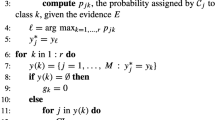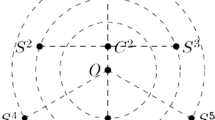Abstract
In various studies, it has been demonstrated that combining the decisions of multiple classifiers can lead to better recognition result. Plurality voting is one of the most widely used combination strategies. In this paper, we both theoretically and experimentally analyze the performance of a plurality voting based ensemble classifier. Theoretical expressions for system performance are derived as a function of the model parameters: N (number of classifiers), m (number of classes), and p (probability that a single classifier is correct). Experimental results on the human face recognition problem show that the voting strategy can successfully achieve high detection and identification rates, and, simultaneously, low false acceptance rates.
Similar content being viewed by others
Explore related subjects
Discover the latest articles, news and stories from top researchers in related subjects.References
Alkoot F, Kittler J (1999) Experimental evaluation of expert fusion strategies. Pattern Recognit Lett 20: 1361–1369
Artiklar M (2002) Capacity analysis of voting networks with application to human face recognition. Ph.D. Thesis, Department of Electrical and Computer Engineering, Wayne State University, Detroit, MI
Dietterich T (1997) Machine learning research: four current directions. AI Mag 18(4): 97–136
Erp M, Vuurpijl L, Schomaker L (2002) An overview and comparison of voting methods for pattern recognition. In: Proceedings of the eighth international workshop on frontiers in handwriting recognition, Canada, pp 195–200
Grother P, Micheals R, Phillips P (2003) Face recognition vendor test 2002 performance metrics. In: Proceedings 4th international conference on audio visual based person authentication, pp 937–945
Ho TK, Hull JJ, Srihari SN (1994) Decision combination in multiple classifier systems. IEEE Trans Pattern Anal Mach Intell 16(1): 66–75
Kittler J, Alkoot FM (2003) Sum versus vote fusion in multiple classifier systems. IEEE Trans Pattern Anal Mach Intell 25(1): 110–115
Kittler J, Hatef M, Duin R, Matas J (1998) On combining classifiers. IEEE Trans Pattern Anal Mach Intell 20(3): 226–239
Kuncheva LI (2002) A theoretical study on six classifier fusion strategies. IEEE Trans Pattern Anal Mach Intell 24(2): 281–286
Kuncheva LI (2004) Combining pattern classifiers: methods and algorithms. Wiley, Hoboken
Lam L, Suen S (1997) Application of majority voting to pattern recognition: an analysis of its behavior and performance. IEEE Trans Syst Man Cybern A 27(5): 553–567
Lin X, Yacoub S, Burns J, Simske S (2003) Performance analysis of pattern classifier combination by plurality voting. Pattern Recognit Lett 24(12): 1959–1969
Mu X (2004) Automated face recognition: a weighted voting method. Ph.D. Dissertation, Department Electrical and Computer Engineering, Wayne State University, Detroit, MI
Phillips P, Moon H, Rizvi S, Rauss P (2000) The FERET evaluation methodology for face-recognition algorithms. IEEE Trans Pattern Anal Mach Intell 22(10): 1090–1104
Ruta D, Gabrys B (2005) Classifier selection for majority voting. Inf Fusion 6(1): 63–81
Tsai D, Tsai Y (2002) Rotation-invariant pattern matching with color ring-projection. Pattern Recognit 35(1): 131–141
Author information
Authors and Affiliations
Corresponding author
Rights and permissions
About this article
Cite this article
Mu, X., Watta, P. & Hassoun, M.H. Analysis of a Plurality Voting-based Combination of Classifiers. Neural Process Lett 29, 89–107 (2009). https://doi.org/10.1007/s11063-009-9097-1
Received:
Accepted:
Published:
Issue Date:
DOI: https://doi.org/10.1007/s11063-009-9097-1




